
In today’s post, I will show you about the Bengal cat’s hypoallergenic.
In Fact: I’m going to show you, Are Bengal cats hypoallergenic? And all the facts around it.
As well as! If you have cat allergies, how do you deal with them?
Let’s dive right in.
- What is Bengal Cat?
- Are Bengal Cats Friendly?
- Are Bengal Cats Hypoallergenic?
- What makes a Bengal cat Hypoallergenic?
- What Causes Cat Allergies?
- Can I own a cat if I’m allergic?
- What To Do If You Want a Bengal and Have Cat Allergies
- How Can I Manage My Cat Allergies?
- Other Hypoallergenic Cat Breeds
- Tips For Reduce Cat Allergies- Allergic Bengal Owners
- FAQ – Are Bengal Cats Hypoallergenic?
- Conclusion – Are Bengal Cats Hypoallergenic?
What is Bengal Cat?
The Bengal cat is a hybrid between the Asian Leopard Cat and a domestic cat. The Asian Leopard Cat is a wildcat that resembles the leopard in terms of markings and builds. The Bengal cat gets its name from the scientific name of its wild cousin, the Asian Leopard Cat. This means the Latin name which we use to categorize animals and their breeds.
The Bengal cat has a robust build and is larger than most domestic cat breeds. Males are larger at between 4.5 and 6.8 kilos with females being a little smaller at between 6.5 and 5.5 kilos.

Their coat is short but thick and very soft to the touch. Breeders will only allow the Bengal cat to have the brindle coat pattern. However, the color may vary with a range of tones including ivory cream yellow gold, and orange colors.
They are insatiable cat who likes to play and surround themselves with those who will pay attention to them. They tend to follow family members around the house and are especially good with kids.
Bengal cats will also get along well with different animals such as other cats dogs and even ferrets. likewise, it is important to remember that every cat is an individual. However, the Bengal cat’s personality and behavior will be influenced by their genetic inheritance.
Are Bengal Cats Friendly?
The Bengal cat is a fun, loving, energetic, athletic, Loyal, and Playful cat. So what do you think? you are correct! the Bengal cat is a very friendly cat. As well as they Get on well with other Pets.
They properly communicate with you using their vocals!
Wonderful thing! They have unbelievably intelligent and have good problem-solving intelligence. They are amazingly affectionate and social cats and will follow you everywhere.
I’m sure!! now you know a lot of information about Bengal cats that you didn’t know before. So now, let’s move into our main part, are Bengal cats hypoallergenic.
Related article – How Can I Make My Cat Happy
Are Bengal Cats Hypoallergenic?

Are bengal cats really hypoallergenic? Yes. they’re hypoallergenic.
Meaning they are less likely than other cats to produce an allergic reaction. But the allergic reaction most people associate with cats doesn’t come from their hair as is often assumed.
They aren’t hairless, and they don’t necessarily generate less Fel D1 protein than other breeds, so what makes Bengals hypoallergenic?
The answer is in their coats.
Bengal cats have very beautiful pelts that require far less upkeep than other breeds. Bengals don’t groom themselves as often or for as long as other cats, and their hair contains less allergen-rich saliva as a result. They also don’t shed much, so whatever dander that is present in their fur isn’t disseminated as much.
Related article – The Best Definitive Manual for Cat Fur Patterns, Colors and Markings
Bengals only have one short, tight coat of hair, which is referred to as a pelt. The hair of other domestic cats is divided into two layers: an undercoat and a topcoat. One pelt means less grooming and, as a result, less allergen-causing saliva pervading their fur. While whether hypoallergenic cats work or not depends on your physiology, Bengals are less likely to aggravate your allergies.
What makes a Bengal cat Hypoallergenic?

So, you already know those cat allergies are caused by the protein found in their dead skin, urine, and saliva.
Your Bengal’s coat will not shed as much as other breeds as it reaches adulthood. They also don’t groom themselves as much as they should. All cats, groom themselves for a variety of reasons, including the desire to be coated in their own aroma, to be clean, and to be exceedingly sensitive to every hair in its proper position. Bengal cats don’t need to spend as much time grooming because their hair is so sleek and low maintenance. Less grooming means there’s less allergy-inducing fur in your home.
What Causes Cat Allergies?
Why am I allergic to my Bengal cat? I think this is a very important part you need to know.
Cat hair does not cause an allergic reaction in you. The issue is a tiny protein called Fel d 1. Fel d 1 is the most common cat allergen, which may be found in a cat’s saliva, urine, and skin cells. This Fel D1 protein found in cat saliva makes you sneeze and feel itchy. When a cat licks its coat, the allergen-laden saliva dries and becomes airborne, increasing the chances of an allergic reaction.
While cat hair does not cause allergies, it is the most common route for saliva and skin cells to get airborne and enter the environment. When cats brush their fur, the allergen causing Fel d 1 protein is shed along with it.
This protein is produced by all cats. However, Bengal cats are one of the few cat breeds that are less likely to cause allergic reactions.
Can I own a cat if I’m allergic?
If you are allergic to cats, you may be able to live with them, but if you have severe allergies that might cause life-threatening responses, you should avoid living with or near a cat. If it is not, Taking the necessary steps can help to mitigate the consequences and impact.
Allergies trapped in their coat, and clean, sweep and vacuum your house regularly to eliminate allergens. You should also keep your cat out of your bedroom and away from your bed.
You spend about a third of your time in bed, and being exposed to cat hair, dander, and other Fel d1 sources in this region can have a significant detrimental influence on your everyday life.
Remember: Any cat and dog may cause reactions in people who are allergic to animals.
What To Do If You Want a Bengal and Have Cat Allergies
Bengal cats are stunning creatures, but what if you or a member of your family is allergic to cats?
Re-homing a Bengal is a difficult process, so it’s always a good idea to test how you’ll respond before buying one as a pet. You should first expose yourself to Bengals, even though it will be difficult and inconvenient.
Finding a Bengal breeder from whom you intend to purchase a Bengal is one of the finest methods to achieve this. Explain your circumstances, arrange a few visits, and spend time with both the kittens and the adults. Keep an eye on any responses you have. Everything should be fine if you don’t have any allergic reactions.
Before putting a deposit on a kitten, keep an eye on your reaction to the Bengals at that cattery.
How Can I Manage My Cat Allergies?

One of the secrets to reducing allergies if you have a cat is to be diligent around the house.
- Vacuuming
First, of course, vacuuming regularly is important and the great thing is that vacuums themselves have come a long way, especially with the advent of HEPA filters and how a lot of these vacuums have HEPA filters in them which course you want.
- HEPA air filters in every room
HEPA air filters help with the smell, and it also helps with any allergens that are floating around. If you’re getting an actual HEPA can reduce up to 99% of floating allergens in your house not just cats but everything else as well.
- Clean carpets with hardwood floors
Always keep carpets and wooden floors clean. I know it sounds like a sacrifice but if you’re allergic and you want to keep hanging out with your cat family members which I hope you want to do. It’s a pretty small sacrifice to make.
- Brushing your cat
That’s more important if you’re allergic to cats. Try if you can have a non-allergic family member do the brushing. If you have a catio you can bring them out to the catio to brush them, so the hair flies off in another direction. You can even brush while wearing a mask and that will help those hairs going up your nose. That’s a great proactive thing you can do and it’s also really good for your cat.
- You don’t have to bathe your cat
Bathing your cat regularly will help this problem it really won’t. It strips your cats of their natural oils. Those oils are not what you’re allergic to it is the saliva and no matter how many times you bathe your cat they’re still going to have saliva.
- Trimming nails
That is also a very important thing. Because again they scratch themselves, they get some of that protein under their nails they give you a little love scratch and now you got it under your skin. So just taking the points off your cat’s nails regularly again is something that you should be doing anyhow.
- Clean cat beds
Another thing you can do is make sure that you’re washing your cat’s bedding regularly. For this, you can use a little sticky roller and make sure that you’re picking up the hair off their beds along with the rest of your furniture.
Other Hypoallergenic Cat Breeds
This hypoallergenic cat list should not be the only thing you consider when researching which breed of cat to adopt. Before making a choice, we recommend contacting an animal shelter or rescue group and meeting the pet.

1. Balinese

Balinese have long hair, and they are very efficient and easily adaptable. Also, they are sociable. The Balinese are sometimes referred to as Siamese. The Balinese are considered to have evolved as a consequence of a spontaneous mutation that occurred when a Siamese cat gave birth to long-haired offspring.
These cats get along well with other pets and children, and they enjoy a nice mix of play and rest.
Balinese is one of the few breeds that produce less of the Fel D1 protein than other cats, thus causing making Balinese great for people with allergies.
2. Oriental Shorthair
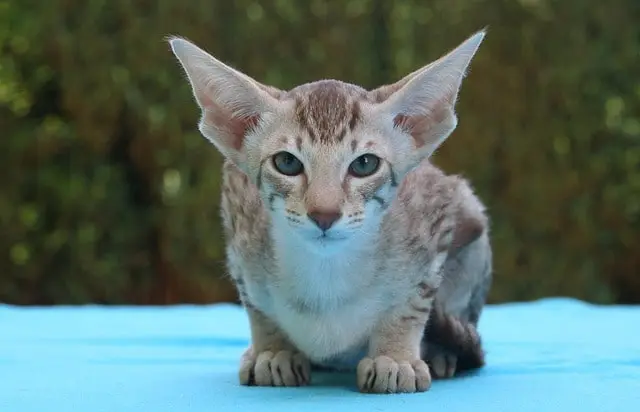
Because of their short coats, Oriental Shorthairs are said to be better for allergy sufferers. These cats have smooth, easy-to-care-for coats that don’t shed excessively. Brushing regularly can help reduce shedding and keep the coat looking its best.
These cats are highly social and will require physical activity or exercise to keep them occupied. Oriental Shorthairs like forming tight bonds with family members.
3. Javanese
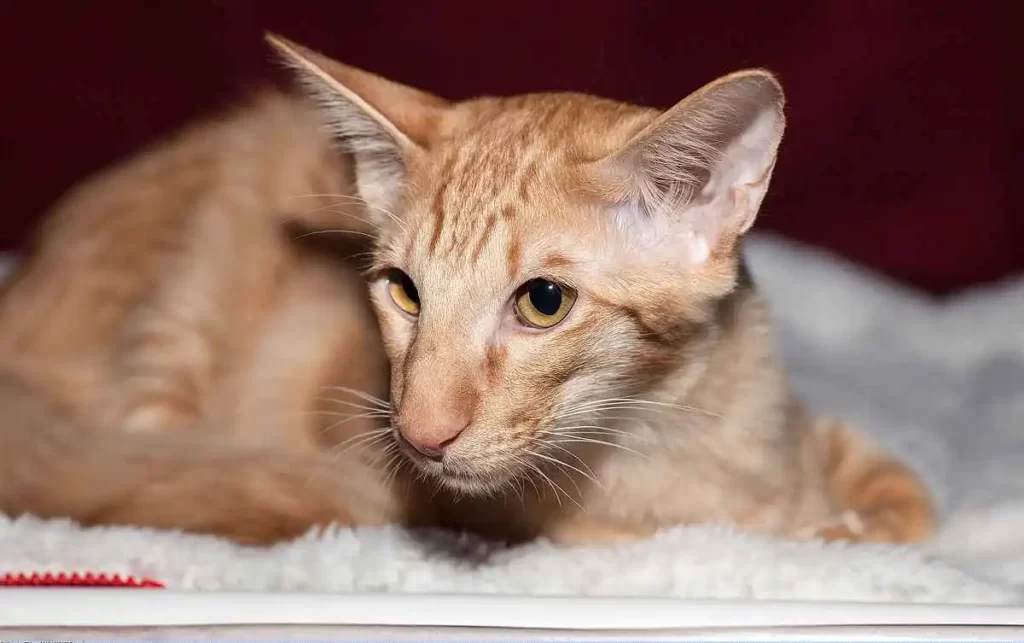
Javanese Siamese cats begin with a cross between a Balinese and a Colorpoint shorthair. The Javanese have a medium-length single coat that does not mat, like the Balinese. They have less fur due to the lack of an undercoat, which means fewer allergies.
Javanese are known for their vocalness. These talkative cats may respond and begin chattering for no apparent reason. Javanese cats are terrific jumpers who like putting their curiosity to good use by examining closets and drawers when they get the opportunity.
The Javanese cat breed is regarded as being one of the least sheddings, and frequent brushing will help reduce allergies.
4. Devon Rex
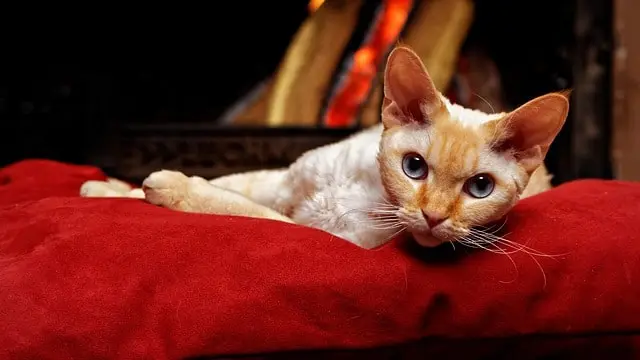
Devon Rex cats have thin fur and shed less than other cat breeds. The Devon Rex’s coat may be wiped off to disperse the natural oils and maintain it clean, but it doesn’t require much maintenance in general.
They’ve been known to snuggle up with you at night and greet you with licks and purrs of affection in the morning. Because the Devon sheds less than other breeds, you may cuddle up without worrying about being covered in cat fur.
5. Cornish Rex

Cornish Rexes have short, curly coats that hug their body. These short, thin coats, shed very little, making them more bearable to allergy sufferers.
Cornish Rexes are energetic, active, curious felines with a gazelle-like appearance. The breed is inquisitive, athletic, and loves to be picked up, unlike many other cats.
Rexes are determinedly outgoing and affectionate toward their human companions. They love attention and will follow you around from one location to the next.
The Devon and Cornish Rex are both good cats for allergies, so pick one that suits your personality.
6. Sphynx
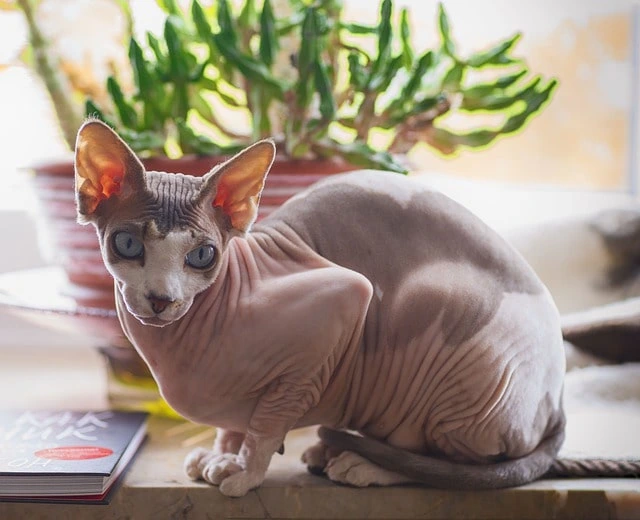
Due to its lack of hair, the hairless Sphynx is generally one of the first cat breeds that allergy sufferers think of, but these cats are not as hypoallergenic as you might expect. Sphynx, like other cats, creates dander, but it may be reduced by washing them frequently, which also helps prevent a buildup of oil on their skin. Also, their large ears will also require frequent cleanings.
Sphynx cats are extroverted, sociable, and a little naughty. They’ll keep you entertained by doing aerialist feats from the tops of bookcases and entrances. This breed is clever, inquisitive, and enjoys.
They are extremely dedicated and loyal to their owners, shaking their tails and purring affectionately.
7. Siberian
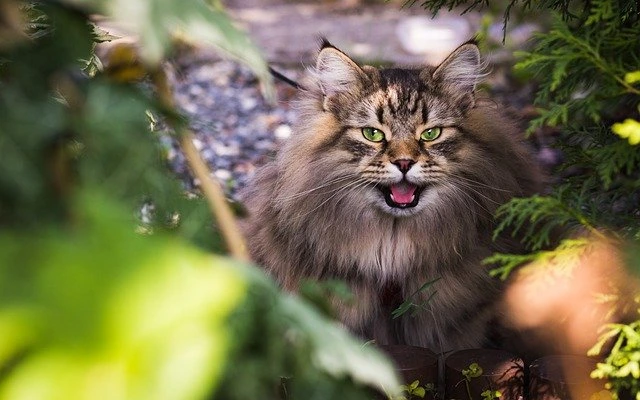
Like the Balinese, the Siberian has a moderately long coat. Siberians are large cats that come in a variety of hues. Siberians are hypoallergenic, due to the lower-than-average enzyme levels in their saliva.
Siberians are energetic and friendly cats with a lot of personalities. They are amenable to handling and are fascinated by water. Siberians are a bright cat breed that can overcome problems to achieve their goals. They are kind to children, other pets, and guests. Despite their size, they are quick and nimble, capable of leaping towering bookshelves in a single bound.
Tips For Reduce Cat Allergies- Allergic Bengal Owners
Adopting a “hypoallergenic” cat may not be a complete solution, but it should help you relax and breathe more easily.
Whether you have a hypoallergenic breed or not, there are things you can do to reduce allergies once you have a cat:

- Feed a species-appropriate diet
- Clean your Bengal
- Use a HEPA air filtration system
- Brush your Bengal
- Keep the litter box clean
- Medicate yourself
FAQ – Are Bengal Cats Hypoallergenic?
1. Are Bengals hypoallergenic cats?
Yes. All Bengal cats are hypoallergenic.
2. What is hypoallergenic mean simply?
‘hypo’ means ‘less than normal’ – so it’s important to understand that ‘hypoallergenic’ does not mean it doesn’t cause allergies, so by definition the Russian Blue or Bengal are both ‘truly hypoallergenic’ – but can absolutely still cause allergies.
As hypoallergenic simply means less likely to trigger allergies. In general, the oriental breeds, with their close-lying coats, and little-to-no fluff, will be less likely to cause an allergic reaction than the fluff-coated cats, both long- and short-haired.
3. What experience have I had with the Bengal Cat’s Hypoallergenic?
My sister, who has to take a pill before visiting a home with a cat, lives perfectly fine with our Bengal. He also has no issues at a friend’s home that owns 2 Bengals and a Savannah. But that may not be the case for everyone.
4. What are the simple things you can do if you have cat allergies?
I will explain this through the experience of a friend of mine.
One of my friends is allergic to cats and got a Bengal. She’s had a cat before so she used to a regiment of allergy pills, but the Bengal was worse than any car I’ve ever had or visited.
After a lengthy chat with her doctor, we decided on the following. Air filters in main rooms, prescription nasal spray in the morning, and a double dose of reactive at night. Works like a charm.
5. What to look for before buying a Bengal cat?
If you want a Bengal cat that is willing to let you test the cat for a week or two in your home to see your reaction go for it. I let a potential customer do that – unfortunately, they still were allergic and had to return the kitten. But better to do a trial run than to have the cat dumped because you are allergic.
Related articles – Before Getting A Cat: 6 Important Things to Consider, and Cat Kidney Disease
Conclusion – Are Bengal Cats Hypoallergenic?
Bengal cats are hypoallergenic, but it doesn’t imply they’re allergy-free; rather, it means they’re less likely to trigger an allergic reaction. If you have allergies and want a Bengal cat, it’s a good idea to see the cat a few times to see how it affects you.
It’s also worth speaking with your doctor about what you may do to lessen your allergy symptoms… since the cat can’t do anything to aid you!
Expand Your Horizons: More Content You Might Enjoy
- Can Cats Have Watermelon?
- Chocolate Bad For Cats?
- Can Cats Have Whipped Cream From Starbucks?
- The Best Definitive Manual For Cat Fur Patterns, Colors And Markings
- How Do Cats Hunt? Here Is About Amazing Cat’s Ability To Hunt
- Cat Kidney Disease | Here Is About Chronic Kidney Disease In Cats
- Gingivitis In Cats: Manifestations, Causes, Stages, Treatment And Anticipation
- Tail Swishing In Cats: Cat’s Tail Language Cool Facts
